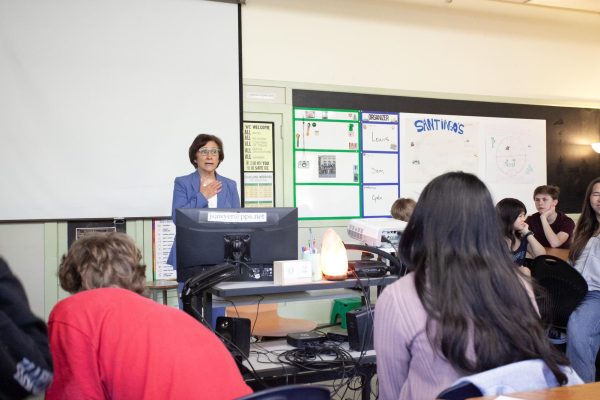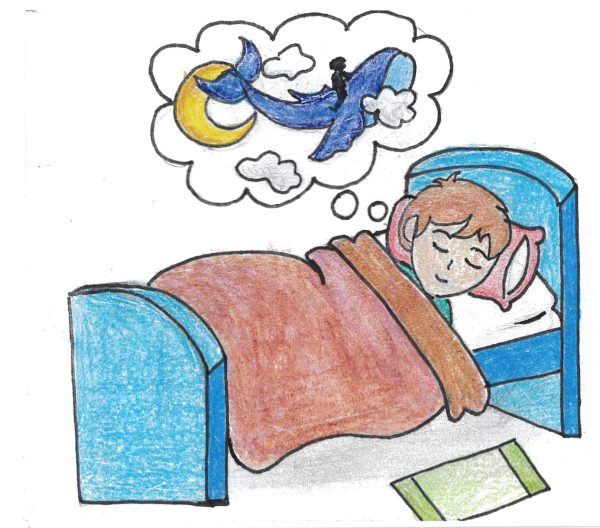SROs For PPS?
With the recent shootings near Portland Public Schools, including Cleveland Dec. 12, the community is debating whether or not to bring back police — so called school resource officers — into the high schools.
Clarion photo Max Miyahira
According to OregonLive, more than 3,600 shootings occurred in Portland since 2019, and more than 25 percent of them have been within a quarter mile of a school. After the recent incidents in PPS communities–including the shootings outside Cleveland, Jefferson, and Franklin high schools–movements regarding SROs have formed after concerns about student safety.
The Cleveland community became part of this statistic on Dec. 12. The school went into lockdown for 10 minutes when gunshots were fired on campus at 12:31 p.m. early into third period. Students were not allowed to leave the building and no one was allowed to enter. Students stayed in their third period class until they were released at 2:30, an hour earlier than the usual release time.
The shooting happened by the fence that restricts access to the gym area, near 28th Avenue and along Franklin Street. Several shots were fired; eyewitnesses noted that the perpetrator was of high school age. The 16-year-old victim suffered a non-fatal wound, left the scene, and walked into a hospital roughly 20 minutes after the shooting. The Enhanced Community Safety Team collaborated with the Portland Police Bureau (PPB) to investigate. On Dec. 17, all involved persons were identified by the PPB, but no public arrests were made.
A few weeks later on Jan. 7, there was a shooting outside of Franklin High School in the east parking lot. It happened during a basketball game and led to the arrest of a 15-year-old juvenile that night (on an unrelated charge of unlawful weapons possession). One juvenile suffered a minor injury that appeared to be a graze wound, police said.
The Franklin incident marked the fourth time there was a PPS-related shooting this academic year. Two Jefferson students were injured Oct. 18, and on Nov. 14, another Jefferson student was injured in a drive-by shooting.
Parents, students, and other community members are presently debating if the reinstatement of School Resource Officers (SROs) would be beneficial. The issue is controversial, and ultimately, PPS Superintendent Guadalupe Guerrero will decide if the district will reimplement.
SROs are police officers who are placed on school campuses to respond to conflicts that arise inside and outside of the school’s campus. Common duties include patrolling the surrounding neighborhood during school hours, policing traffic outside the school, investigating threats, and responding to instances of violence in and around the school. According to Portland’s city-wide incident response data, 50% of the 5,211 calls for classroom service during the 2018-19 school year involved an SRO response. The majority of calls made originated from school or community members, yielding 45 restorative justice interventions and only 20 arrests. In 2019-20, the number decreased to only 11 arrests for outstanding warrants.
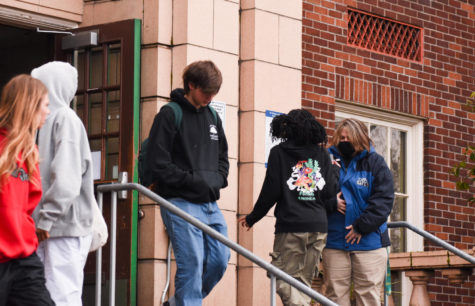
In June 2020 the PPS board made the decision to end the PPSConnect program, which included removal of SROs. This came in the wake of George Floyd’s murder, pushback from community members, along with major pushback from then-commissioner JoAnn Hardesty.
The recent spate of shootings, though, has prompted authorities to take another look at possibly reinstating SROs.
In a press conference on Dec. 14, Portland Police Chief Chuck Lovell mentioned the potential of police presence returning to schools. “I have had some discussions with PPS around what we can do to keep children safe in the short term, but there are also longer-term conversations that we’ve just started around what a return to schools might look like. We’re very early in those discussions.”
At that conference, Mayor Ted Wheeler did not confirm the reimplementation of SROs in the schools but did promise “a closer collaboration between the Portland Police Bureau and school districts.”
Cleveland Principal JoAnn Wadkins echoed these sentiments: “What we’re going to see at a minimum is a better working relationship with the police – lines of communication. But it’s complicated to think about bringing officers into a building, because for some people, having an armed person in the building doesn’t feel safe. So, we have to have multiple perspectives and a multi-pronged approach that involves working together with our care for each other, different community stakeholders, and outreach resources.”
That line of communication continued with Superintendent Guerrero, who, earlier this year, met with students from Grant, Lincoln, Cleveland, and Ida B. Wells to get feedback from students on the presence of SROs at schools.
“We will continue to have focus groups with parents, teachers, and administrators invited in so we can take a look at what that support will look like in the future,” said Wadkins.
A police officer was temporarily reinstated to Jefferson from the November break to winter break, however, “anything longer than that would have to be a more formal arrangement with the district,” according to PPB Sergeant Kevin Allen.
There is a significant push for SROs from Portland staff, students, and parents. Kristen Downs, a Cleveland parent, started a petition on Change.org to bring back SROs after the Franklin shooting incident. Her petition has 653 signatures as of March 9.
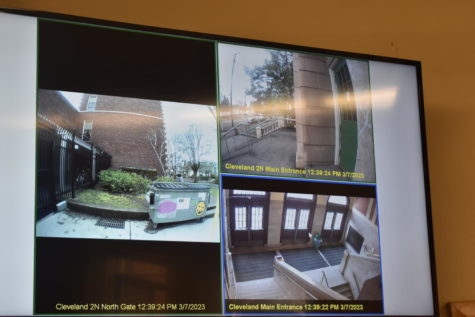
According to Downs, “SROs that are specially trained forge positive relationships with students, whether teaching in the classroom, lunchtime conversations, or attending PIL games, concerts and events. SROs are trained to work in tandem with educators, counselors, mental health professionals, and Youth-Violence-Prevention-and-Response Managers to proactively address school safety issues, divert at-risk students from the juvenile justice system, and deter violence, while providing ALL students with the support they need to succeed in school and in life,” she said.
Downs continued,“In the past year there have been multiple drug overdoses and school shootings. This rampant violence in PPS does not discriminate. Enough is enough! We must tell the PPS Superintendent, School Board and Administration that specially trained SROs are urgently needed to ensure student, teacher and staff safety and deter crime.”
Wadkins said reimplementation would be a district-wide decision. “I’m very glad that the district is going to meet with different focus groups, and I know that there are community members that feel strongly one way or the other. All of that feedback will go through district leadership as we make decisions to move forward.”
While still supporting the continuation of SROs in the district, board member Julia Brim-Edwards did not agree that the school district should begin paying for the SROs expense–as public safety is a city responsibility. Brim-Edwards sent the Clarion the following statement:
“As a parent and school board member, the increase in gun violence in our community and near our schools is highly concerning and calls for a partnership between the city, the school district and our school community. We have already taken action and will continue to improve security and student safety, including hiring more Campus Safety Associates at our high schools, contracting with the police bureau for a presence at large sporting events, and making changes to our buildings to create safer school buildings, such as adding more cameras and upgrading exterior door locks and planning for the installation of interior door locks.
I am going to listen to the concerns of parents, students, and school staff and continue to seek the advice of Franklin Principal Frazier, law enforcement, and district staff on whether the reinstatement of school resource officers should be considered as an additional support to ensure student and school safety.”
While community members are working on these safety upgrades, there is no set date for cameras to be installed. Danielle Cota told the Clarion, “We do not have a timeline for cameras.”
Some students and staff members are not in favor of the return of SROs. Angella Bonilla, president of the Portland Association of Teachers, said the teacher’s union is “supportive of every measure that can lead to safety before we get to having SROs.” The union believes student health resources like clinics and therapists, as well as door locks, cameras, and lights should all be prioritized over SROs.
The union was in favor of the 2020 removal of SROs, citing the funding for SROs being pulled from the PPS budget as a reason for removal: “Why would we divert money from classrooms to bring cops into schools?” Bonilla said. She also reported that at the time, union members had had positive experiences with SROs. However, for some students and educators the presence of officers produced “discomfort and trauma.”
Hazel Beard, the president of CARE, is in agreement. She recognizes that many parents and students are divided, but from her perspective, “As a woman of color, SROs would NOT make me feel safer at all. I have heard negative security stories and seen them unfold in the hallways myself. When security already unknowingly (or knowingly?!) targets students of color in the hallway but let’s white kids go, what will happen when we bring in armed SROs that are allowed to make arrests on campus? It feels like an accident waiting to happen. We already know that militarizing schools disproportionately negatively affects students of color,” Beard said.
Beard argued, “It has also not been proven that bringing back SROs even stops gun violence/school shootings, so in the long run, it’s just more shots fired and a lot of money given to a harmful cause (SROs) that could have been better spent elsewhere. We have tons of amazing programs and a school that is falling apart. With the school already having to make budget cuts and losing some teachers this year because of it, why would we spend money to bring in SROs if it doesn’t prevent but only exacerbates the problem we are trying to solve? […] I hope that the people who want SROs in our school really think critically about why they believe that SROs will make them feel safer.”
Cleveland’s Black Student Union President Kennidee Gillespie has said, “I personally don’t feel like we should have SROs in school, because they will target mostly students of color.”
A sophomore who wished to remain anonymous shared a similar impression.“Guns don’t belong in schools and that includes people who are meant to protect us. I agree we could have better security, but I don’t believe officers are the solution. Many people for SROs talk about the mental health benefits they have, but if that’s the goal, why not invest more in social workers and connection with students?”
Constructively, “Putting more focus on the Middle Schools could make a difference since early life can change these outcomes. As for protecting students from gun violence, I think maybe we should focus on better security measures instead. Better protection of the perimeter and making connections with students who are more at risk,” the sophomore said.
Mason Bregoli, a junior, said, “It could really go either way. It might make some students feel unsafe at school, but I think some students might feel more safe. It depends on how they grew up and what values they have. I have been thinking a lot about it, and I’m still not sure, but I don’t love the idea of there being a gun on this resource officer in schools. I think that there are times when I would be thankful to have somebody like that in our school.”
The re-implementation of SROs in Portland Public High Schools is a highly debated issue. While some believe that SROs in schools could potentially increase safety, others think that it is not the best solution to combat the recent instances of gun violence in Portland. Many of the collected interviews, specifically from students, are not in support of the reimplementation, but the conversation will continue.
Hello! My name is Henry Callahan and this is my 4th year on the Clarion. I spent my first 3 years writing for the News team and now I am the Online Editor....

Hi! This is my third year writing for The Clarion, I most enjoy reporting on administrative changes, writing opinion pieces about different cultural observations,...
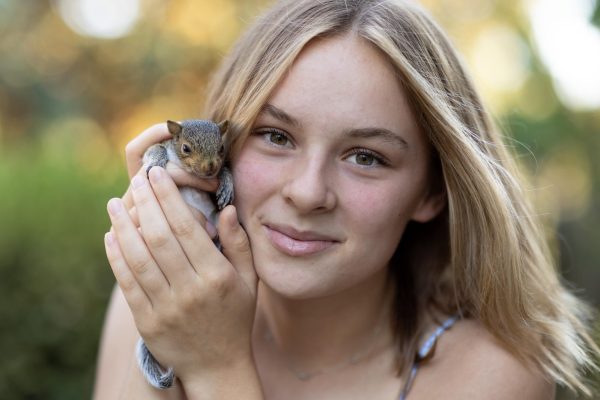
Hi I'm Lloy! This is my third year writing for The Clarion. Fun fact about me is that I'm a twin.
My name is Min, and I'm a Junior at Cleveland. This is my second year on the Clarion, and I'm the Clarion photography editor. Woohoo!






